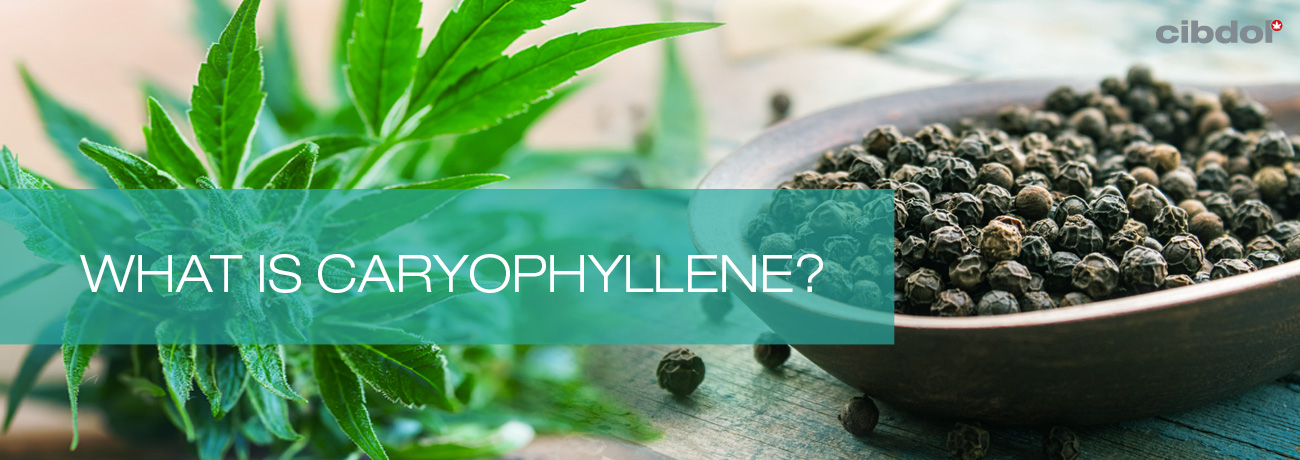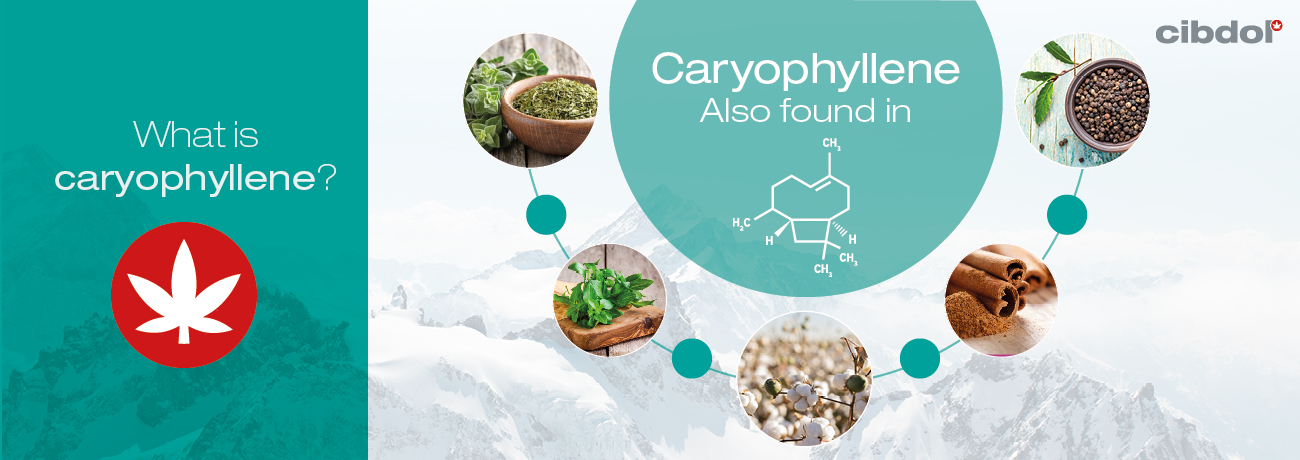What is caryophyllene?

Caryophyllene belongs to a group of cannabis constituents known as terpenes. More specifically, the molecule ranks as a sesquiterpene because of the three isoprene units in its structure. As one of the most abundant terpenes in cannabis, caryophyllene occurs in large quantities in many cultivars. It’s valued for its unique tastes and aromas, but the molecule also offers therapeutic potential.
Unlike other terpenes, caryophyllene plays the role of a cannabinoid, much like CBD. Its unique structure allows it to bind to the CB2 receptor of the endocannabinoid system. Let’s take a deeper look at caryophyllene, its characteristics, and medicinal potential.
Aroma
Caryophyllene produces aromas of pepper, spice, and cloves. Because it occurs in relatively large quantities, it plays a large role in the signature scent of flowering hemp and cannabis plants.
Also found in
Caryophyllene can be found elsewhere in nature. The molecule underpins the recognisable and earthy scents of black pepper, basil, hops, cinnamon, and oregano. Researchers have labelled caryophyllene as a “dietary cannabinoid[1]” because of its widespread presence in many culinary herbs and spices. Interestingly, caryophyllene offers diners the opportunity to modulate their endocannabinoid system through the ingestion of food. As science discovers more about this molecule, its popularity will most likely increase.

Possible effects
Researchers have studied caryophyllene in-depth. Despite a shortage of clinical trials, animal studies have demonstrated wide-ranging medicinal potential. Caryophyllene achieves its effects in part through the endocannabinoid system, as well as other mechanisms. So far, studies have identified[2] the following properties:
• Antioxidant
• Neuroprotective
• Antimicrobial
• Gastroprotective
• Anticonvulsant
• May reduce inflammation
• May reduce pain
• May help to treat alcoholism
Supporting research
Although these effects are encouraging, they have not yet been confirmed in humans. However, studies conducted on cells and animals give us an idea of how caryophyllene might be beneficial to human subjects.
Caryophyllene may hold the key to future treatments for anxiety and depression. So far, it seems to be effective in rodents. An animal study[3] published in the journal Physiology & Behavior found caryophyllene to produce behavioural changes relevant to anxiety and depression in mice. The rodents were subject to a battery of tests known to measure mental distress, anxiety, and depression.
Researchers found that administration of caryophyllene reduced levels of anxiety, depression, and compulsive behaviours. The authors of the paper attribute these effects to the terpene's ability to bind to the CB2 receptor—a site implicated in anxiety and depression. These findings were confirmed when researchers gave mice a substance that blocks CB2 receptors. When the sites were blocked, caryophyllene no longer produced the same effects.
Interestingly, caryophyllene may help to break the cycle of alcohol addiction—a disorder partially rooted in the dopamine reward system. Research[4] published in the journal Pharmacology Biochemistry and Behavior states that CB2 receptors in the brain could play a role in alcohol reward.
In their study, researchers decided to test the effects of caryophyllene on alcohol consumption in boozing mice. They allowed the rodents to drink from two bottles, one filled with alcohol, the other with water. Researchers made the bottle of booze stronger by the day. After receiving caryophyllene injections, the mice voluntarily reduced their alcohol intake. What’s more, they chose to partake again after the researchers administered CB2 receptor blockers. The researchers state that the CB2 receptor system appears to be involved in alcohol dependence, and could be a future target for treating alcoholism.
Caryophyllene—and its affinity for the good old CB2 receptor—may also help to reduce inflammation and neuropathic pain. Several studies suggest the involvement of the CB2 receptor in the modulation of both states. A 2014 study[5] published in the journal European Neuropsychopharmacology tested caryophyllene in mice to observe its potential anti-inflammatory and painkilling effects. Researchers found that the dietary cannabinoid was able to reduce late-phase inflammation due to its action on the CB2 receptor.
However, caryophyllene showed no effect on early phase inflammation. In regards to neuropathic pain, caryophyllene was able to reduce heat caused by temperature and spinal neuroinflammation. The researchers concluded that the results suggest dietary factors could play an important part in the modulation of these conditions.
Caryophyllene also appears to reduce seizures. A study[6] in Epilepsy & Behavior shows how an “anticonvulsant” dose of caryophyllene was able to reduce the severity of seizures in mice. The researchers suggest that the terpene should be studied further for the development of anticonvulsant drugs.
[1] Gertsch, J., Leonti, M., & Raduner, S. (2008). Beta-caryophyllene is a dietary cannabinoid. NCBI. https://www.ncbi.nlm.nih.gov/pmc/articles/PMC2449371/ [Source]
[2] Russo, E. B., & Marcu, J. (2017). Cannabis Pharmacology: The Usual Suspects and a Few Promising Leads. Cannabinoid Pharmacology, 67–134. https://doi.org/10.1016/bs.apha.2017.03.004 [Source]
[3] Bahi, A., al Mansouri, S., al Memari, E., al Ameri, M., Nurulain, S. M., & Ojha, S. (2014). β-Caryophyllene, a CB2 receptor agonist produces multiple behavioral changes relevant to anxiety and depression in mice. Physiology & Behavior, 135, 119–124. https://doi.org/10.1016/j.physbeh.2014.06.003 [Source]
[4] al Mansouri, S., Ojha, S., al Maamari, E., al Ameri, M., Nurulain, S. M., & Bahi, A. (2014). The cannabinoid receptor 2 agonist, β-caryophyllene, reduced voluntary alcohol intake and attenuated ethanol-induced place preference and sensitivity in mice. Pharmacology Biochemistry and Behavior, 124, 260–268. https://doi.org/10.1016/j.pbb.2014.06.025 [Source]
[5] Klauke, A. L., Racz, I., Pradier, B., Markert, A., Zimmer, A., Gertsch, J., & Zimmer, A. (2014). The cannabinoid CB2 receptor-selective phytocannabinoid beta-caryophyllene exerts analgesic effects in mouse models of inflammatory and neuropathic pain. European Neuropsychopharmacology, 24(4), 608–620. https://doi.org/10.1016/j.euroneuro.2013.10.008 [Source]
[6] Oliveira, C. C. D., Oliveira, C. V. D., Grigoletto, J., Ribeiro, L. R., Funck, V. R., Grauncke, A. C. B., Souza, T. L. D., Souto, N. S., Furian, A. F., Menezes, I. R. A., & Oliveira, M. S. (2016). Anticonvulsant activity of β-caryophyllene against pentylenetetrazol-induced seizures. Epilepsy & Behavior, 56, 26–31. https://doi.org/10.1016/j.yebeh.2015.12.040 [Source]
[1] Gertsch, J., Leonti, M., & Raduner, S. (2008). Beta-caryophyllene is a dietary cannabinoid. NCBI. https://www.ncbi.nlm.nih.gov/pmc/articles/PMC2449371/ [Source]
[2] Russo, E. B., & Marcu, J. (2017). Cannabis Pharmacology: The Usual Suspects and a Few Promising Leads. Cannabinoid Pharmacology, 67–134. https://doi.org/10.1016/bs.apha.2017.03.004 [Source]
[3] Bahi, A., al Mansouri, S., al Memari, E., al Ameri, M., Nurulain, S. M., & Ojha, S. (2014). β-Caryophyllene, a CB2 receptor agonist produces multiple behavioral changes relevant to anxiety and depression in mice. Physiology & Behavior, 135, 119–124. https://doi.org/10.1016/j.physbeh.2014.06.003 [Source]
[4] al Mansouri, S., Ojha, S., al Maamari, E., al Ameri, M., Nurulain, S. M., & Bahi, A. (2014). The cannabinoid receptor 2 agonist, β-caryophyllene, reduced voluntary alcohol intake and attenuated ethanol-induced place preference and sensitivity in mice. Pharmacology Biochemistry and Behavior, 124, 260–268. https://doi.org/10.1016/j.pbb.2014.06.025 [Source]
[5] Klauke, A. L., Racz, I., Pradier, B., Markert, A., Zimmer, A., Gertsch, J., & Zimmer, A. (2014). The cannabinoid CB2 receptor-selective phytocannabinoid beta-caryophyllene exerts analgesic effects in mouse models of inflammatory and neuropathic pain. European Neuropsychopharmacology, 24(4), 608–620. https://doi.org/10.1016/j.euroneuro.2013.10.008 [Source]
[6] Oliveira, C. C. D., Oliveira, C. V. D., Grigoletto, J., Ribeiro, L. R., Funck, V. R., Grauncke, A. C. B., Souza, T. L. D., Souto, N. S., Furian, A. F., Menezes, I. R. A., & Oliveira, M. S. (2016). Anticonvulsant activity of β-caryophyllene against pentylenetetrazol-induced seizures. Epilepsy & Behavior, 56, 26–31. https://doi.org/10.1016/j.yebeh.2015.12.040 [Source]












